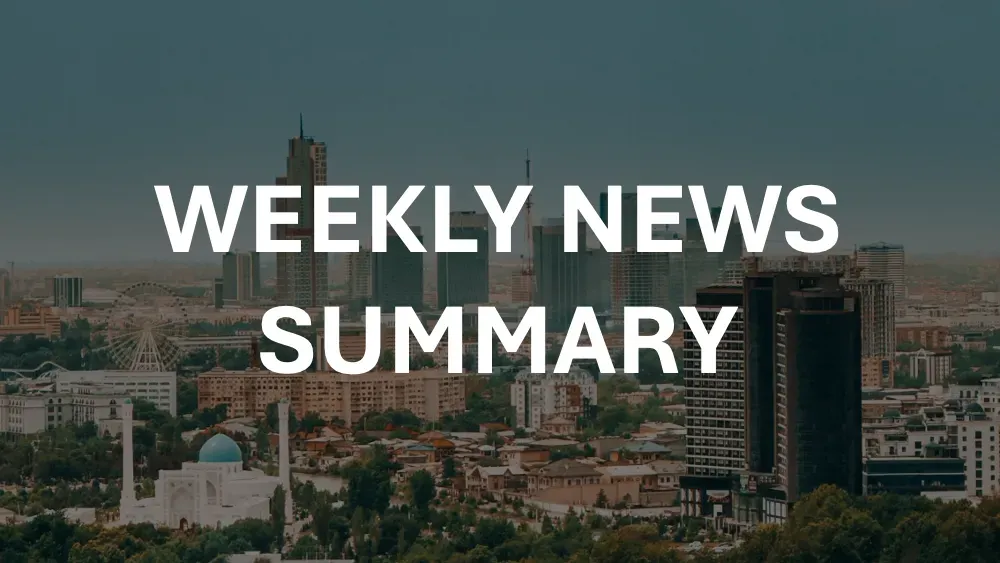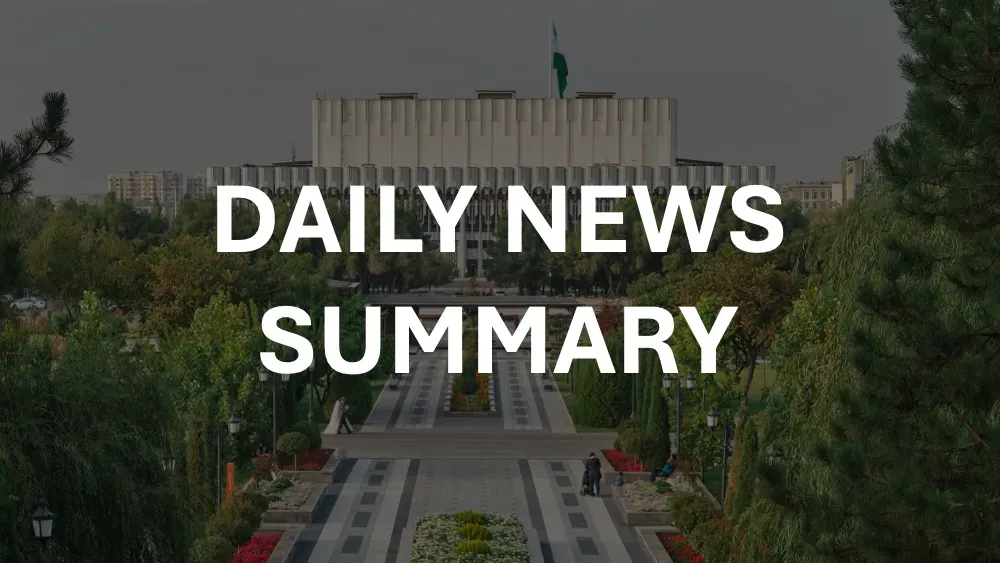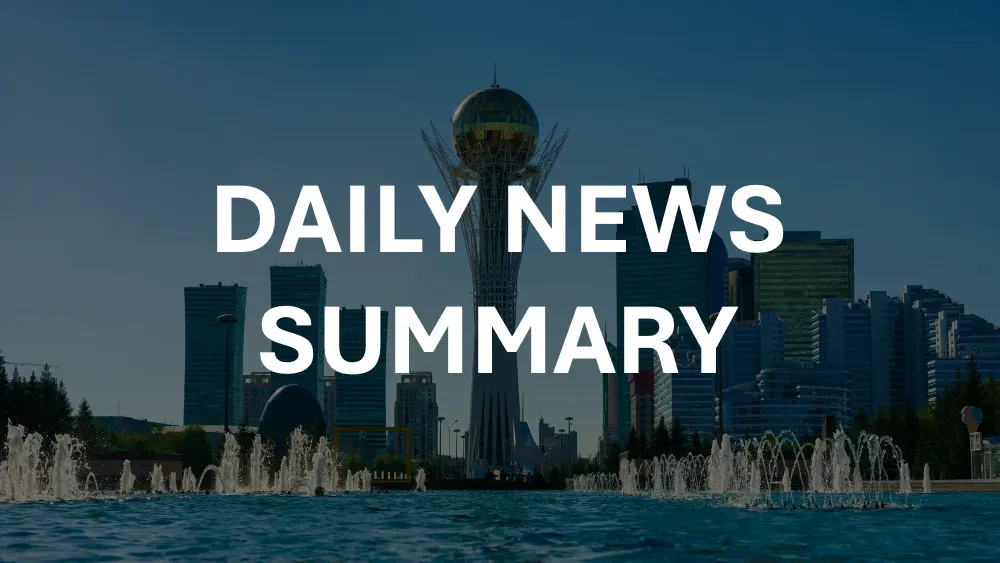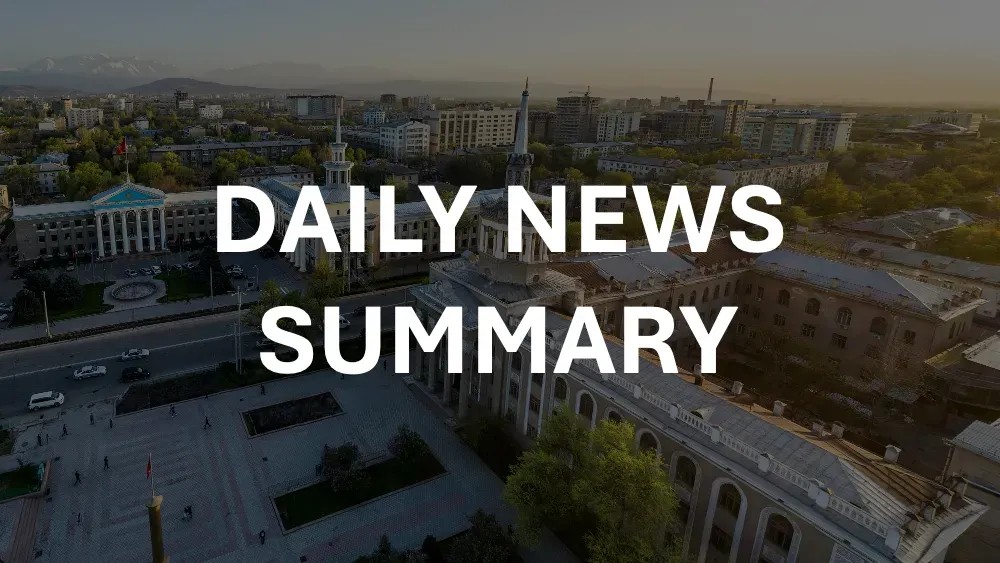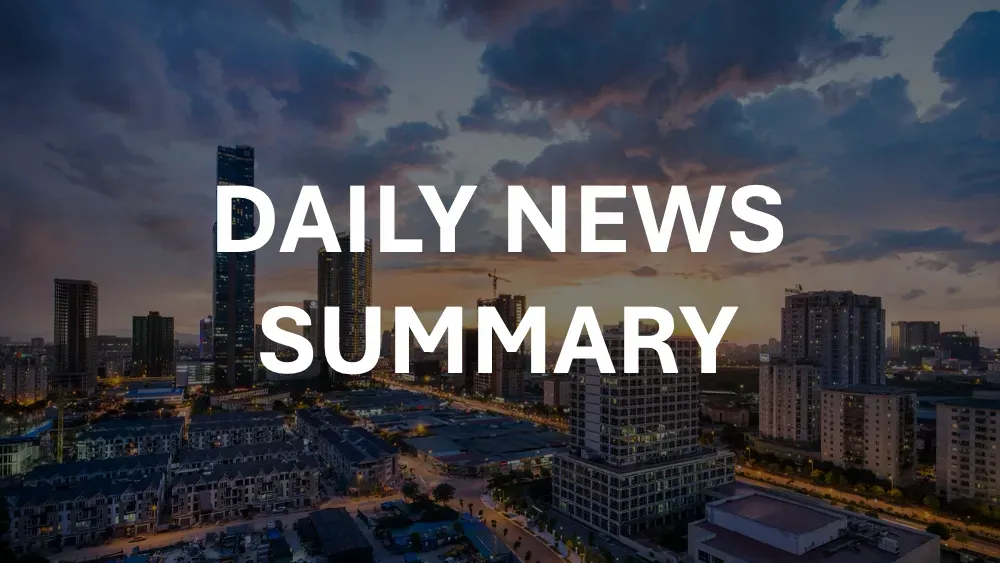This weekly digest showcases just 10 stories. Daily subscribers receive comprehensive intelligence briefs with 40 of the top stories organized by category. Don't miss the stories that matter.
Subscribe to Daily →
September 26, 2025 to October 2, 2025
This week's top 10 stories from Uzbekistan, selected from our daily intelligence briefs.
1. External Debt Climbs to $72.2 Billion as Trade Gap Narrows and Investment Inflows Rise
Uzbekistan’s total external debt rose to $72.2 billion as of July 1, up $8.1 billion in H1 2025, split roughly equally between public ($36.8bn) and corporate ($35.4bn) obligations—growth driven largely by state-linked corporates and banks and underscoring continued reliance on external financing for budget and investment needs (about $2,000 per capita). At the same time the current‑account deficit narrowed to $156.3 million as exports climbed 29% to $16.6 billion (January–July basis reported) and imports grew 10% to nearly $23 billion, helped by a record $8.42 billion in gold exports in January–August 2025; net FDI rose 42% y/y to $1.6 billion and portfolio inflows (notably sovereign and corporate Eurobonds) reached $3.1 billion.
External buffers strengthened: international reserves increased to $48.5 billion (reported) and to $50.1 billion as of September 1 with more than $40 billion held in gold (11.8 million oz), lifting the net international investment position to $16.9 billion. Trade turnover hit $51.4 billion in January–August 2025 (exports $22.98bn, imports $28.45bn), narrowing the trade deficit to $5.47bn; trade with 200 partner states expanded but shows sectoral shifts—textiles up modestly (58.5 trillion soums produced, exports ~$1.7bn), gold dominant at 36.7% of exports, weakening flows to China but gains to Afghanistan, Turkey and Russia—signals investors should watch policy support, energy reliability and market diversification to sustain non‑gold export growth.
Local Coverage: qalampir.uz, gazeta.uz, kun.uz, anhor.uz, uzdaily.uz
From daily briefs: 2025-09-26, 2025-09-27, 2025-09-30, 2025-10-02, 2025-10-03
2. $70 Billion Portfolio of 600+ Industrial Projects Advances with CIS and EAEU Partners
Uzbekistan has launched more than 600 joint industrial cooperation projects with partners from the Commonwealth of Independent States (CIS) and the Eurasian Economic Union (EAEU), representing a combined portfolio exceeding $70 billion, Prime Minister Abdulla Aripov announced at the Innoprom exhibition in Minsk. Aripov highlighted Uzbekistan’s drive to deepen regional industrial ties and expand manufacturing capacity; Uzbek firms showcased over 150 categories of domestically produced high‑quality goods at the event.
The annual “Innoprom. Central Asia” forum in Tashkent — now in its fifth edition — has become a major deal-making platform, drawing some 11,000 participants from 35 countries this year and generating more than $5 billion in project and trade agreements. Aripov signaled readiness to further develop cooperation and to encourage partner participation in future Innoprom events, underscoring Uzbekistan’s strategic push to integrate with CIS/EAEU value chains and attract regional investment.
Local Coverage: uzdaily.uz
From daily brief: 2025-10-02
3. Tashkent Accedes to Vienna Convention on Civil Liability for Nuclear Damage
Uzbekistan formally acceded to the 1963 Vienna Convention on Civil Liability for Nuclear Damage after presidential approval on 26 September, completing legislation passed by the Oliy Majlis in May–June. The treaty imposes strict (absolute) liability on nuclear‑facility operators for damage from incidents at installations under their control, subject to narrow exceptions (war, civil unrest, force majeure, and damage to the operator’s own property), sets a minimum operator liability of US$5 million at the 1963 gold parity (roughly US$480 million today), requires states to define national liability limits and financial security, and prescribes a 10‑year claims period with jurisdiction in courts of the state where an incident occurs.
Accession obliges Uzbekistan to enact a dedicated domestic law to specify operator liability, required financial guarantees and litigation procedures as it advances both large and smaller nuclear projects in Jizzakh. For international professionals—regulators, insurers, project financiers and developers—the move signals tighter operator risk allocation, potential adjustments to project financing and insurance structures, and the need to align contractual and regulatory frameworks with Vienna Convention requirements.
Local Coverage: gazeta.uz
From daily brief: 2025-09-30
4. Chinese Rail Delegation Assesses Andijan Site for Logistics Hub on China–Kyrgyzstan–Uzbekistan Corridor
A delegation led by Wang Lisin, Deputy General Director of China State Railway Group, visited Andijan to assess a proposed logistics center tied to the China–Kyrgyzstan–Uzbekistan (CKU) railway corridor. The team was formally received at Andijan railway station, attended a project presentation, and inspected the site to discuss required works; no investment figures or timelines were disclosed. The visit signals increased cross‑border coordination aimed at diversifying Central Asia’s transport corridors and positioning Andijan as a key node for future CKU freight flows.
The delegation’s mix of technical review and cultural engagement (visits to Babur Park and museum) reflects infrastructure diplomacy intended to build local rapport as planning shifts toward early implementation. For international logistics and rail professionals, the mission indicates moving beyond concept toward site readiness—an important step for stakeholders tracking CKU corridor viability, potential modal shifts in regional freight, and opportunities for public‑private involvement.
Local Coverage: uzdaily.uz
From daily brief: 2025-09-30
5. Data Localization Rules Blamed for Stifling Cloud Adoption and Startup Growth
An Uzbek entrepreneur warns that recent data localization requirements are deterring global cloud adoption and stifling startup growth by forcing firms to use domestic data centers that lack sufficient capacity and are costly to access. Startups typically depend on AWS, Azure and Google Cloud—none of which operate local server farms in Uzbekistan—so compliance imposes complex, expensive alternatives; Akmal Payziyev (kun.uz) specifically blamed Uztelecom’s monopoly for making new data-center investment “almost impossible.”
The constraints raise practical risks for technology firms and investors: slower product rollouts, higher operating expenses, and incentives to base infrastructure abroad rather than localize, which could shrink the local digital ecosystem. Without regulatory flexibility or diversified, affordable data-center options to break market concentration and enable competitive cloud services, Uzbekistan may struggle to attract global platforms and scale domestic startups.
Local Coverage: kun.uz
From daily brief: 2025-09-28
6. US–Uzbekistan Sign Memorandum to Expand Nuclear Energy Cooperation
Uzbekistan and the United States signed a memorandum of understanding on civilian nuclear cooperation, establishing a framework for expanded collaboration between specialists and industry. The agreement was signed by Uzbekistan Deputy Foreign Minister Muzaffarbek Madrahimov and Brent Christensen, U.S. Deputy Assistant Secretary for Arms Control and International Security; Washington framed the move as part of broader efforts to deepen economic ties and investment in nuclear energy and critical minerals.
The memorandum complements Tashkent’s preparations for its first nuclear power plant and follows recent Uzbek Senate approval to join the Vienna Convention on Civil Liability for Nuclear Damage, which creates insurance and compensation mechanisms needed for international project participation. U.S. officials emphasized the deal aligns with U.S. policy to bolster its nuclear industry’s global competitiveness.
Local Coverage: gazeta.uz
From daily brief: 2025-09-27
7. Russia and Uzbekistan expand joint training pipeline for integrated nuclear power project
Russia and Uzbekistan convened a joint working group in Moscow to accelerate workforce development tied to Uzbekistan’s planned integrated nuclear power plant, reviewing a national staffing plan, personnel selection, and support measures for young specialists. The parties mapped interim steps under a tripartite roadmap with NRNU MEPhI that include launching an “Advanced Engineering School” at MEPhI’s Tashkent branch by October 2025, opening a radiological monitoring and dosimetry lab by year-end, introducing R&D labs in energy auditing, photovoltaics and nanotechnology, starting graduate nuclear programs next academic year, and expanding internships at Rosatom facilities from Q1 2026; mid-level technical training will be developed in Forish, Jizzakh.
The initiative is part of a broader Russia–Uzbekistan push to scale education-to-industry pipelines for transport and infrastructure modernization tied to Uzbekistan’s 2030 growth targets. Transmashholding and Tashkent State Transport University have launched an “Innovative Rail Transport” center to upskill metro and railway staff, provide internships at TMX sites in Russia, and run recruitment hackathons for rolling-stock renewal and potential joint manufacturing. Officials frame these measures—supported through the Eurasian Development Bank framework and blended finance—as critical to meeting staffing needs, boosting transit and export–import capacity, and advancing long-term technological independence in energy and engineering.
Local Coverage: kun.uz, uzdaily.uz, anhor.uz
From daily briefs: 2025-09-27, 2025-10-01
8. US Energy Partnerships Advance with $3–4B Pipeline, Power and Downstream Projects
Uzbekistan’s Energy Ministry has reached preliminary agreements with U.S. firms on a $3–4 billion portfolio of energy projects that span gas transport electrification, upstream technology upgrades, coal-to-chemicals and downstream retail expansion, Energy Minister Jo‘rabek Mirzamahmudov said following meetings in New York. Key components include a two- to three-year, minimum $800 million program to replace gas-driven compressors with electric motors across compressor and booster stations (with the U.S. EXIM Bank indicating interest and a potential $852 million credit line); Air Products’ proposed coal gasification and syngas-based production of ammonia and methanol; and service agreements with Schlumberger and Baker Hughes to introduce advanced drilling technologies.
The deals also cover a roughly $100 million memorandum between state oil firm Uzbekneftegaz and Gulf to build a nationwide fuel-station network. For international investors and operators, the package signals Uzbekistan’s push to leverage U.S. capital and technology to accelerate modernization of its energy infrastructure and develop higher-value chemical and downstream capacity, while layering public financing (EXIM) and private-sector technology partners to de-risk project execution.
Local Coverage: gazeta.uz, anhor.uz, uzdaily.uz, kun.uz
From daily briefs: 2025-09-29, 2025-10-02, 2025-10-03
9. Central Bank Links High Lending Rates to Inflation and Preferential Credit Practices
Central Bank Governor Timur Ishmetov said Uzbekistan’s high lending rates reflect persistent inflation and inflation expectations, which keep the “price of money” elevated and constrain the central bank’s ability to cut rates administratively. He argued that state-directed subsidized lending has distorted market pricing—larger shares of preferential credit raise overall rates—and that unwinding this distortion will take time because reducing inflation is a prerequisite.
Ishmetov also linked high real deposit rates to households’ inflation expectations and to some banks’ shift into higher‑risk, high‑interest microloans, which forces competitors to raise deposit offers to retain funds. The regulator is addressing household debt burdens and plans tighter supervisory norms to curb aggressive bank practices, with new measures due to be announced by year‑end.
Local Coverage: anhor.uz
From daily brief: 2025-09-27
10. Jizzakh Nuclear Project Advances with Public Hearings, Excavation Timeline and Potential Expansion
Uzbekistan is moving from planning to implementation on a Rosatom-partnered nuclear complex in Jizzakh, combining two Generation III+ VVER‑1000 reactors (2 GW total) and two 55 MW RITM‑200N SMRs (110 MW) on a 525‑hectare footprint within a larger 1,000+‑hectare approved site. Uzatom director Azim Axmedkhadjayev said public hearings with international experts will begin soon and feedback may adjust the project; excavation for SMR works is slated this autumn with “first concrete” for the SMR as early as March 2026, and commissioning targets of 2029 (first SMR), 2033 (first large unit) and 2035 (second large unit). Equipment manufacture and fuel-supply arrangements are reportedly underway, though final dates depend on a pending contract and regulatory permits.
Analytically, the phased “multi‑track” strategy—using SMRs as an early supply and learning platform before larger units come online—aims to strengthen baseload capacity, lower post‑payback generation costs, and free gas for higher‑value uses. Authorities are also assessing expansion to up to four large units at Jizzakh and potential siting of additional SMRs elsewhere. The project’s co‑location of operating SMRs and large reactors would be a global first and carries implications for regional industrial development, workforce training with Rosatom, and Uzbekistan’s long‑term energy and economic planning.
Local Coverage: uzdaily.uz, gazeta.uz, anhor.uz, kun.uz, uza.uz
From daily briefs: 2025-09-27, 2025-09-30, 2025-10-01
About This Weekly Digest
The stories above represent the most significant developments from Uzbekistan this week, selected through our AI-powered analysis of hundreds of local news articles.
Stories are drawn from our daily intelligence briefs, which synthesize reporting from Uzbekistan's leading news sources to provide comprehensive situational awareness for international decision-makers.
These weekly highlights are a small sample of what's happening. Daily subscribers get comprehensive briefings with 40 top stories that connect the dots between events, track developing stories, and provide the context you need for informed decision-making.
Upgrade to Daily →
